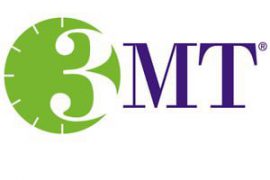The Centre for Research on Learning and Innovation has formed a new special interest group on students partnerships. Read on to find out more about students’ reflections on being partners in a previous Sydney Teaching Colloquium, and the lessons they took away.
The Student Colloquium Ambassadors were a wonderful highlight of the 2014 Sydney Teaching Colloquium (STC). They were Amanda Clifford (Health Sciences), Annette English (Education), Jananie Janarthana (Arts and Social Sciences), Chelsea Jones (Health Sciences), Matt Teal (Education / Arts) and Jessica Zhang (Arts).
Identifiable in their orange t-shirts mingling among the crowd, they carried the responsibility of evaluating this year’s event. And what they had to offer did not disappoint. Gently leading the day 2 audience through their three criteria for evaluating the effectiveness of this year’s STC (attendance, collaboration, and quality of the ideas), their final message to Colloquium attendees about assessment was this: “use the research to inform assessment design; make it relevant, intriguing and challenging; help us see the rationale for the task; give us feedback that is timely and future-focused; and provide opportunities for us to make sense of our feedback.”
@stc_ambassadors spoke to more academics in past 2 days than ever had before & got a good insight into what academics do #sydteach14 – Amani Bell
Over the course of four months, the ambassadors worked with Amani Bell and Tai Peseta in the (then) Institute for Teaching and Learning, (now) Educational Innovation to:
- develop a social media marketing campaign to engage the Sydney student community in the STC before, during, and after the event;
- design a creative student session on assessment for presentation at the STC;
- devise and executive an STC evaluation strategy drawing on a range of research methods and data sources that capture senior leaders, staff, and students’ experiences of assessment and feedback;
- present the findings from the evaluation strategy at the closing of the STC;
- curate and develop resources in the form of text, artefacts, objects, images of the STC (particularly students’ experiences of assessment) that can be re-used for a range of educational purposes to support assessment development work across the university; and
- contribute to the planning and writing of a co-authored paper which was published in the International Journal for Academic Development, and can be read here.
Sydney Students on Assessment say challenge us and intrigue us with the contemporary topics in the field #sydteach14 – Tina Barclay
Here’s how the ambassadors described their experiences of being involved:
Amanda: “It was exciting to be taken seriously by academic staff”
 A major highlight of being involved in the 2014 STC for me was the continuous and positive interactions and encounters with academic staff from all fields and disciplines – before, during and after the event. Some of these academics had a formal role at the STC (keynotes, presenters and guests) and my job was to interview them (Chris Rust was my favourite). Other academics I spoke to were just interested in better understanding what the ambassador role involved. During these conversations, I also had opportunities to further explore and develop my understanding of assessment. I listened a lot, and got drawn into quite a few one-on-one chats. I really found it surprising how open, positive and engaging the academic staff were, and how interested they were in finding out what data I’d collected and what I’d made of it so far. They were enthusiastic in answering the questions I had, and they seemed happy enough to spend time with me explaining their own views, the things about assessment they were personally interested in, or confused about. The main thing I learned by being an ambassador was that academics are genuinely interested in students’ opinions and ideas. This has already influenced the way I interact and engage with the academic staff involved teaching and assessing me, and my work.
A major highlight of being involved in the 2014 STC for me was the continuous and positive interactions and encounters with academic staff from all fields and disciplines – before, during and after the event. Some of these academics had a formal role at the STC (keynotes, presenters and guests) and my job was to interview them (Chris Rust was my favourite). Other academics I spoke to were just interested in better understanding what the ambassador role involved. During these conversations, I also had opportunities to further explore and develop my understanding of assessment. I listened a lot, and got drawn into quite a few one-on-one chats. I really found it surprising how open, positive and engaging the academic staff were, and how interested they were in finding out what data I’d collected and what I’d made of it so far. They were enthusiastic in answering the questions I had, and they seemed happy enough to spend time with me explaining their own views, the things about assessment they were personally interested in, or confused about. The main thing I learned by being an ambassador was that academics are genuinely interested in students’ opinions and ideas. This has already influenced the way I interact and engage with the academic staff involved teaching and assessing me, and my work.
Matthew: “Understanding how academics organise their time”
 A powerful step for students when connecting with academic staff is achieving an understanding of what academics and universities actually do. Before being involved as a student ambassador, I tended to view my lecturers and tutors in the same way that I had viewed my school teachers – although with such a large cohort of students I was aware that there was limited time to engage with us individually. This illusion acts as a powerful obstacle, which I think can get in the way of achieving honest and consistent dialogue between staff and students. During one of the sessions, I came to understand a little about the way academics organise their time and that there is a workload ratio which can help to explain how they spend their working time (and why they may not spend as much on assessment and feedback as students might wish them too): 40% devoted to research, 20% to service, and only 40% to teaching. We also learned that academics get promoted based largely on their research achievements (although we learned that this had been changing too). I found this information at first very disorienting but it helped me to see a key contradiction that I was unaware of previously: that many academics want to do more for students, yet they are limited by time. Being an ambassador also opened my eyes to how big the university is, and how the financial and business pressures on it might be at odds with its teaching function. One of the main goals of our presentation at the STC was to give academics our insights about how to engage with students in time-effective ways. This new perspective helped me to see that while staff could do more to engage with students, we also have a responsibility to get involved in initiatives like the STC as well. I know these opportunities are rare (and there should be more of them) but I’m really looking forward to figuring out what I can do to see academics as partners in shaping my own learning future.
A powerful step for students when connecting with academic staff is achieving an understanding of what academics and universities actually do. Before being involved as a student ambassador, I tended to view my lecturers and tutors in the same way that I had viewed my school teachers – although with such a large cohort of students I was aware that there was limited time to engage with us individually. This illusion acts as a powerful obstacle, which I think can get in the way of achieving honest and consistent dialogue between staff and students. During one of the sessions, I came to understand a little about the way academics organise their time and that there is a workload ratio which can help to explain how they spend their working time (and why they may not spend as much on assessment and feedback as students might wish them too): 40% devoted to research, 20% to service, and only 40% to teaching. We also learned that academics get promoted based largely on their research achievements (although we learned that this had been changing too). I found this information at first very disorienting but it helped me to see a key contradiction that I was unaware of previously: that many academics want to do more for students, yet they are limited by time. Being an ambassador also opened my eyes to how big the university is, and how the financial and business pressures on it might be at odds with its teaching function. One of the main goals of our presentation at the STC was to give academics our insights about how to engage with students in time-effective ways. This new perspective helped me to see that while staff could do more to engage with students, we also have a responsibility to get involved in initiatives like the STC as well. I know these opportunities are rare (and there should be more of them) but I’m really looking forward to figuring out what I can do to see academics as partners in shaping my own learning future.
Jessica: “Address unequal power between staff and students by establishing dialogue”
 The balance of power between teachers and students matters, and it matters particularly when it comes to the quality of teaching and the nature of assessment. I think it is crucial that both sides acknowledge how power affects the teacher and the student differently. To me, good communication is central to how power plays out in the learning process. Students come to the learning process with expectations about the subject or course, and teachers need good communication skills to draw out and learn from students’ expectations. As part of the ambassador role, I was surprised to learn that many academics are not trained as teachers; that formal teaching courses are not compulsory; and that only a small proportion of academics take up opportunities to formally develop their teaching knowledge and skills (at least at this university). In learning of this, it made me think about how teachers are able to address issues of power inequality without any training. Would they be blind to power and its effects on student learning and assessment? Is the establishment of genuine dialogue and partnership between students and teachers really possible? The STC showed me that there are academic staff who are concerned about these issues, and that they too are struggling with how best to start conversations with students. I was glad to be there for that reason alone!
The balance of power between teachers and students matters, and it matters particularly when it comes to the quality of teaching and the nature of assessment. I think it is crucial that both sides acknowledge how power affects the teacher and the student differently. To me, good communication is central to how power plays out in the learning process. Students come to the learning process with expectations about the subject or course, and teachers need good communication skills to draw out and learn from students’ expectations. As part of the ambassador role, I was surprised to learn that many academics are not trained as teachers; that formal teaching courses are not compulsory; and that only a small proportion of academics take up opportunities to formally develop their teaching knowledge and skills (at least at this university). In learning of this, it made me think about how teachers are able to address issues of power inequality without any training. Would they be blind to power and its effects on student learning and assessment? Is the establishment of genuine dialogue and partnership between students and teachers really possible? The STC showed me that there are academic staff who are concerned about these issues, and that they too are struggling with how best to start conversations with students. I was glad to be there for that reason alone!
Chelsea: “We can no longer just expect the academics to be working to make the change”
 Before being involved as a student ambassador, I didn’t know that there was a research area dedicated to assessment and feedback, and it was surprising to learn about the different theories surrounding this area. One of the primary reasons I applied to be a student ambassador was because I thought I could communicate the ideas from the student community about how assessment and feedback could be improved. I soon found out that the thoughts from the student community were paralleled in the research. For example, Gibbs and Simpson (2004-2005) suggest that feedback should be provided often, in enough detail, and timely. It was reassuring to hear that students’ ideas about how to improve assessments are reflected in the research.
Before being involved as a student ambassador, I didn’t know that there was a research area dedicated to assessment and feedback, and it was surprising to learn about the different theories surrounding this area. One of the primary reasons I applied to be a student ambassador was because I thought I could communicate the ideas from the student community about how assessment and feedback could be improved. I soon found out that the thoughts from the student community were paralleled in the research. For example, Gibbs and Simpson (2004-2005) suggest that feedback should be provided often, in enough detail, and timely. It was reassuring to hear that students’ ideas about how to improve assessments are reflected in the research.
During the STC, I attended many presentations including the keynotes (Boud & Rust). Both explored similar themes and made similar suggestions for improvement. However, it surprised me that if there is consensus in the literature about how to improve assessment and feedback, why is it not always up to standard? In my experience, there is often an attitude among students that the goal is a good grade rather than learning a deep understanding of the subject matter. We often see assessment as the route to a good GPA rather than a learning opportunity. It was also surprising to learn that in order to improve assessment, students need opportunities to self-assess, and to actively engage and act on their feedback in order to receive the benefits for learning. For me, this is quite a novel idea because once I have handed in an assessment task, unless there is another related to it, I assume the learning process is over. However, I now realise that the real learning comes from using the feedback to improve next time. As students, we have a major role to play in improving assessment. We can no longer just expect the academics to be working to make the change.
One of the other big surprises from being an ambassador was learning that hardly any of this extensive research was actually being implemented in real time. Although I now have a greater understanding of the complexities behind assessment and the regulation of standards, I have come to realise that effective assessment does not necessarily mean mass change but can come out of simple yet effective changes.
Jananie: “I was motivated to explore additional research opportunities”
 Through the experience of being an ambassador, I came to better understand how such a large institution worked. I also developed my ideas about what my potential academic/career trajectory could be and I got motivated to explore additional research opportunities at the university. I just received an 8-week summer scholarship to undertake research in the Charles Perkins Centre – the university’s flagship interdisciplinary health and medical learning hub. And one of the academics who was at the STC will be my supervisor on a project that I have devised myself! The ambassador role gave me a lot more confidence to see academics as approachable, and to take up the opportunities provided by the university to support me. I know that sadly, not every student has these opportunities and so I fully support the university’s efforts to develop undergraduate students as future researchers and leaders of institutional change. Through the STC, my understanding of graduate attributes has grown and changed too (and what it means to have them embedded within the curriculum). I have also realised that students have an important role in asking questions about assessment tasks and standards. Part of our job is to keep the university accountable, and to make sure we inform ourselves of the opportunities it provides to further our learning.
Through the experience of being an ambassador, I came to better understand how such a large institution worked. I also developed my ideas about what my potential academic/career trajectory could be and I got motivated to explore additional research opportunities at the university. I just received an 8-week summer scholarship to undertake research in the Charles Perkins Centre – the university’s flagship interdisciplinary health and medical learning hub. And one of the academics who was at the STC will be my supervisor on a project that I have devised myself! The ambassador role gave me a lot more confidence to see academics as approachable, and to take up the opportunities provided by the university to support me. I know that sadly, not every student has these opportunities and so I fully support the university’s efforts to develop undergraduate students as future researchers and leaders of institutional change. Through the STC, my understanding of graduate attributes has grown and changed too (and what it means to have them embedded within the curriculum). I have also realised that students have an important role in asking questions about assessment tasks and standards. Part of our job is to keep the university accountable, and to make sure we inform ourselves of the opportunities it provides to further our learning.





